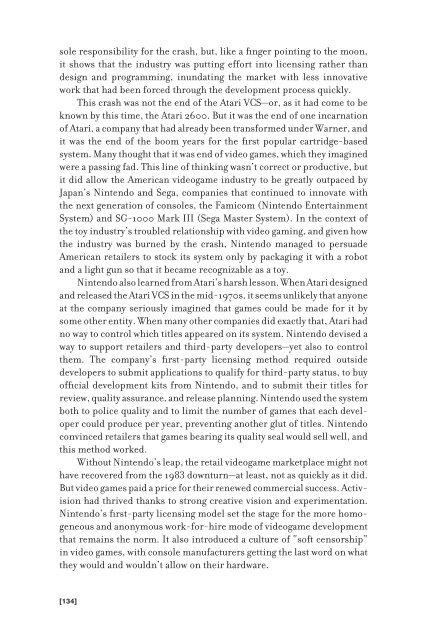Racing the Beam : the Atari Video Computer System - Index of
Racing the Beam : the Atari Video Computer System - Index of
Racing the Beam : the Atari Video Computer System - Index of
Create successful ePaper yourself
Turn your PDF publications into a flip-book with our unique Google optimized e-Paper software.
sole responsibility for <strong>the</strong> crash, but, like a fi nger pointing to <strong>the</strong> moon,<br />
it shows that <strong>the</strong> industry was putting effort into licensing ra<strong>the</strong>r than<br />
design and programming, inundating <strong>the</strong> market with less innovative<br />
work that had been forced through <strong>the</strong> development process quickly.<br />
This crash was not <strong>the</strong> end <strong>of</strong> <strong>the</strong> <strong>Atari</strong> VCS—or, as it had come to be<br />
known by this time, <strong>the</strong> <strong>Atari</strong> 2600. But it was <strong>the</strong> end <strong>of</strong> one incarnation<br />
<strong>of</strong> <strong>Atari</strong>, a company that had already been transformed under Warner, and<br />
it was <strong>the</strong> end <strong>of</strong> <strong>the</strong> boom years for <strong>the</strong> fi rst popular cartridge-based<br />
system. Many thought that it was end <strong>of</strong> video games, which <strong>the</strong>y imagined<br />
were a passing fad. This line <strong>of</strong> thinking wasn’t correct or productive, but<br />
it did allow <strong>the</strong> American videogame industry to be greatly outpaced by<br />
Japan’s Nintendo and Sega, companies that continued to innovate with<br />
<strong>the</strong> next generation <strong>of</strong> consoles, <strong>the</strong> Famicom (Nintendo Entertainment<br />
<strong>System</strong>) and SG-1000 Mark III (Sega Master <strong>System</strong>). In <strong>the</strong> context <strong>of</strong><br />
<strong>the</strong> toy industry’s troubled relationship with video gaming, and given how<br />
<strong>the</strong> industry was burned by <strong>the</strong> crash, Nintendo managed to persuade<br />
American retailers to stock its system only by packaging it with a robot<br />
and a light gun so that it became recognizable as a toy.<br />
Nintendo also learned from <strong>Atari</strong>’s harsh lesson. When <strong>Atari</strong> designed<br />
and released <strong>the</strong> <strong>Atari</strong> VCS in <strong>the</strong> mid-1970s, it seems unlikely that anyone<br />
at <strong>the</strong> company seriously imagined that games could be made for it by<br />
some o<strong>the</strong>r entity. When many o<strong>the</strong>r companies did exactly that, <strong>Atari</strong> had<br />
no way to control which titles appeared on its system. Nintendo devised a<br />
way to support retailers and third-party developers—yet also to control<br />
<strong>the</strong>m. The company’s fi rst-party licensing method required outside<br />
developers to submit applications to qualify for third-party status, to buy<br />
<strong>of</strong>fi cial development kits from Nintendo, and to submit <strong>the</strong>ir titles for<br />
review, quality assurance, and release planning. Nintendo used <strong>the</strong> system<br />
both to police quality and to limit <strong>the</strong> number <strong>of</strong> games that each developer<br />
could produce per year, preventing ano<strong>the</strong>r glut <strong>of</strong> titles. Nintendo<br />
convinced retailers that games bearing its quality seal would sell well, and<br />
this method worked.<br />
Without Nintendo’s leap, <strong>the</strong> retail videogame marketplace might not<br />
have recovered from <strong>the</strong> 1983 downturn—at least, not as quickly as it did.<br />
But video games paid a price for <strong>the</strong>ir renewed commercial success. Activision<br />
had thrived thanks to strong creative vision and experimentation.<br />
Nintendo’s fi rst-party licensing model set <strong>the</strong> stage for <strong>the</strong> more homogeneous<br />
and anonymous work-for-hire mode <strong>of</strong> videogame development<br />
that remains <strong>the</strong> norm. It also introduced a culture <strong>of</strong> “s<strong>of</strong>t censorship”<br />
in video games, with console manufacturers getting <strong>the</strong> last word on what<br />
<strong>the</strong>y would and wouldn’t allow on <strong>the</strong>ir hardware.<br />
[134]


